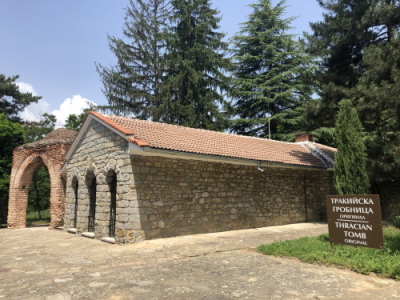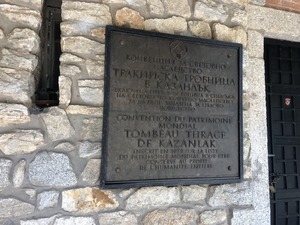Thracian tomb of Kazanlak

The Thracian Tomb of Kazanlak is a masterpiece of Thracian creative art.
The monument is a vaulted brickwork "beehive" (tholos) tomb, that used to be part of a large Thracian necropolis. It comprises a narrow corridor and a round burial chamber, both decorated with well-preserved murals representing a Thracian couple at a ritual funeral feast.
Community Perspective: Unfortunately we are not allowed to visit the interior of the original masterpiece and have to make do with a replica. Be aware that it’s very small (about 3x3m). There are more authentic tombs in the rural areas around Kazanlak (on the T List as Seuthopolis) which are worth visiting – an extension to include those would make this WHS stronger.



Map of Thracian tomb of Kazanlak
Community Reviews
Clyde

I visited this WHS in 2023. Unlike the Thracian Tomb of Sveshtari, the Thracian Tomb of Kazanlak is right in the middle of a very urban setting, almost like Malta's Hypogeum of Hal Saflieni, although at least it has a small park area as a buffer zone. This contains the closed original tomb with a dome and the latest protective structure, rightly marked as the original tomb. Like at the original Lascaux cave in France's Vezere Valley, there's nothing much to see here apart from the UNESCO WHS inscription plaque which is proudly displayed here.
A few hundred metres away, there is the accessible replica tomb which consists of a hallway, a rectangular antechamber and a round burial chamber. The wall with the entrance to the antechamber is covered with stucco. Although the entrance is 1.96 metres high and 0.72 metres wide at the base, its sides tilt smoothlt to a certain height and then they abruptly narrow down in order to form a pointed triangle at the top (do mind your head when going in and especially when going back out!). The entrance between the two chambers is covered with plaster and fully decorated with colourful ornamentation. The burial chamber has a diameter of 2.65 metres and is 3.25 metres high. A beehive-like bell shaped dome is formed by gradually declining the rows of sector bricks and precise reversal of the dome curve in two places, closed at the top with a keystone.
The walls were plastered with clay and covered with white stucco, preserved only at a small area on the eastern wall. The floor of the antechamber is painted in Pompeian red. The architrave is reduced to two narrow bands, the lower one coloured in yellow and the upper one coloured in red, followed above by a pearl string and a bluish shade on a black base. A plant frieze on a black background follows and in the central part of each of the long walls there is a red and light grey palmette, with greyish pink tendrils running outwards. The murals are complete by figured friezes with war scenes on the dome. Central for each scene is a couple of warriors, joined by armed infantry and horsemen, galloping from both sides. Their armament is represented above all by different types of helmets, short spears and shields.
Towards the edge of the dome painting there are three fascias, on which there are 12 alternating rosettes, 12 four-leaf rosettes and 12 bukrani. Above them, in a central position, there are three figures: a Thracian nobleman, crowned with a golden crown and seated on a low stool, his wife wearing a veil and a tiara on her head, sitting on a throne, and a woman in peplos stepping towards them with a tray in her hands. On both sides of this group a procession is formed. Behind the woman in peplos a young man is depicted carrying a jug and a cup in his hands. Two musicians in long coats follow, then two warriors leading saddled horses, and women bearing gifts. The top of the dome is decorated by a race of 3 chariots or bigae pulled by two horses each. The frieze is divided into three fields by 3 Ionic columns.
The Kazanlak tomb replica is open every day and admission is free every last Monday of the month. Although the original paintings and tomb in my opinion truly possess OUV, and judging by the lack of colour in the Sveshtari and Seuthopolis tombs the use of a replica tomb is justified, the visitor experience can only truly be enhanced by visiting the other accessible tombs at the remarkable royal necropolis of the Thracian city of Seuthopolis (currently tWHS extension) and the worthwhile National Archaeological Museum in Sofia.
CugelVance

I visited the thracian tomb of kazanlak on the 16th of jan,early in the morning of that day. The day before I had arrived in Kazanlak around 18.00 in the afternoon by train from Burgas via Sliven. The first thing I had encoutered after leaving the railway station in Kazanlak was a place where a huge group of people was dancing to traditional bulgarian music. Fascinating. I asked them if I could join them.Well,my moves were stiff,but the locals were extremely friendly. They explained me that every sunday in most bulgarian cities there is public dancing to traditional music which can be joined by whoever wants to.A wonderful idea to promote native and traditional music and dances in our globalized world.
As for the thomb my hotel was a stone's throw away so that I was exactly at 9.00 at the entrance of the tomb. However,the person working there was not ............there. After 30 min a female employe finally arrived. She didnt expect any visitors and obviously hadnt been in a hurry to get to her working place. Quite annoying! Whats more .....like in most bulgarian and romanian cities packs of dogs roam the parks and public places(just a few days ago a female jogger,a scientist,had been killed by a pack of dogs in Romania's capital Bucharest......two big dogs turned up when I arrived at the entrance of the thomb which is located on a hill at the entrance of a city park. There were quite harmless but just the day before on my way to Kazanlak when I had a stop in the run-down city of Sliven to visit the castle ruins there I had a truly traumatic experience.
The day before it was foggy in Sliven. I visited the castle ruins in Sliven, a fenced off area for which you have to pay a very small sum of money as an entrance fee.
Well,no locals visit that area,and there are no foreign visitors in Sliven. I was alone in that fenced off area walking around when a pack of 6-7 big dogs turned up approching me like ghosts comming out of the fog and chasing me on a ruin wall. Highly aggressive dogs, I still thank God that there was a wall just 20 meters behind my back on which I could jump......no time for climbing.. . I collected some stones and threw them at the dogs. They disappeared as rapidly as the apppeared. But......then the real horror began........ I had to cross around 250 meters through the ruins area to get to the exit. Fog was everywhere.At times you could hear the dogs. I wasnt interested in those ruins anymore. 3 days later I was supposed to board a flight to Abu Dhabi from Sofia.
A bite would mean........................vaccination against rabies,trouble,spending time in locating doctors or clinics,and so on. A bite could jeopordize my trip to the emirates and gulf states. Hell,even my life was in danger. Nobody was there........it was a fenced off area....I had no weapons....only some stones....the dogs were highly aggressive ones......
What an unpleasant situation it was! Well,who do I encounter just in front of the entrance to the thracian tomb in Kazanlak......two big street dogs.....this time harmless ones,but I didnt feel really confortable and relaxed waiting for the thracian site's employee.
Anyway! The tomb is only a copy and you just need 5 minutes to see everything there. Not really worth a visit. One of the most underwhelming and boring unesco sites I have ever seen.
However, luck and destiny were on my side again.
One of the sons of the family who runs the hotel offered me to drive me with his car to some thracian tombs in the schipka area,around 15 min by car away from Kazanlak.I visited four tombs(Shushmanets,Griffins,Helvetia, and Arsenalka if I remember correctly) there,authentic ones and far more interesting ones than the copy in Kazanlak.
I agreed to pay him 15€ for the trip but at the end he refused to accept the money.....happens in a lot of countries....first you are a client ,then you become a friend from whom you cant accept money...
At least I ve written an excellent review of the family run hotel and its fantastic bulgarian restaurant.
Airpunk

The Thracian tomb of Kazanlak was discovered in 1944 when soldiers were digging trenches in order to protect from air raids. They were named an UNESCO world heritage site in 1979 making it one of the earliest named at all. The original tomb was once in a mound. After its discovery, a small house was built over it in order to protect it. This original tomb is not accessible to the general public. Only scholars with permit from the ministry of culture may enter it. For some time, it was possible to peek into this tomb by looking through iron bar windows in the rear part of the house.
Just a couple metres away is an 1:1 scale replica with a short explanation about the place's history and some items discovered in the tomb.
From a historian's point of view, I can imagine that the Thracian tomb of Kazanlak has a distinctive importance since its frescoes are considered to be the best preserved of the Thracian era in Bulgaria.
From a touristical point of view, the place is fine for a fifteen minute visit (which includes walking around the original) but not more. If ticking off an UNESCO WHS is your only reason to come here, you might be disappointed. It is an incredibly tiny place. The sign asking you not to enter the tomb replica with more than four people is quite sarcastic as I can't imagine how four average-sized male visitors with a light backpack would enjoy it without feeling some kind of claustrophoby.
Although this is the only place where you can really get an impression on hand of how the original looks like, I would consider the exhibition in Kazanlak's history museum far more informative.
Els Slots

Kazanlak is a fairly nondescript city in the center of Bulgaria. I drove there directly from another WHS – Pirin National Park. It’s a 4-hour drive. They don't really advertise the fact that they hold a true World Heritage Site within the city limits: a painted Thracian Tomb from the 4th century BC. There are signs here and there, but I mainly had to trust the navigation on my phone. The drive ended at the foot of a long staircase in a residential neighbourhood. So this is it?
The visitor experience of this tomb has changed considerably over the years if we look at the reviews that go back to even before 2009. People used to be still allowed into the original tomb for an extra / unofficial fee. That “tomb”, discovered in 1944, now is no longer recognizable as a tomb: a chapel-like building has been placed around it. It is hermetically sealed. There is a helpful sign next to it that says “Thracian Tomb. Original”. It is worth peeking through the iron bars at the front as the WHS plaque is visible from there.
The replica with a more tomb-like appearance lies next to it. A lady is selling tickets (6 Lev / 3 EUR) and some souvenirs. I was the only visitor. I read about guided visits, but the only thing that I got was being directed to an information panel on the wall in Bulgarian and English. And then you have to enter the tomb: there is a narrow corridor a few meters long, the vault of which is also already covered with murals.
The most beautiful, however, is the domed burial chamber itself. This is completely covered with scenes of Thracian dignitaries at court and on the road. People and horses are depicted in action. The images of horses especially are captivating.
However - before you know it you'll be outside again. It would be very hard to spend more than 5 minutes in there. I found it hardly worth the long drive. The good news however is that the intention is that in time this WHS will be extended to include 8 more Thracian royal tombs. They are on Bulgaria’s Tentative List as The royal necropolis of the Thracian city of Seuthopolis. They can be found along the road between Sjipka and Kazanlak. They stand out easily in the flat landscape.
Together they comprise an extension that for once would make an existing WHS stronger. First, because the original tombs are accessible here in the “Valley of the Thracian Kings”. Second, the many burial mounds in the landscape remind of the time when the royal city of Seuthopolis was located here. And third, they show a variety in architectural design that is less prominent in the Kazanlak Tomb. None of them has the great murals, but there are still great original works to be found in situ such as the carved white marble doors at the Tomb of Seuthes III and the decorated gates of Shushmanets. Some of these tombs were only discovered in 2004, so 25 years after the WH inscription of Kazanlak. It is about time that they are added.
Tsunami
Japan / USA / Europe - 04-Feb-17 -

After abandoning visits to 4 WHSs and wasting 4 full days in north-eastern Bulgaria due to winter closure and massive snow, I was able to visit only one new WHS in Bulgaria during this trip: the Thracian Tomb of Kazanlak, which is open year-around no matter what.
But there were at least two surprises.
The first was that the interior of the real tomb has not been accessible for the general public since 2013, and the only option was to visit a replica of the tomb they created recently for a few Euros. Remembering how meticulously the replica of the Lascaux Cave was created (Lascaux ll) in France , I went with that option. After all, Kazanlak was inscribed in the same year as Lascaux (and Pyramids of Egypt and Grand Canyon).
The second and bigger surprise came after I paid a few Euros. After the fiasco in north-eastern Bulgaria, I had a somewhat high expectation for this site, particularly with the replica of Lascaux in my mind. When I walked through a narrow entrance hall to the small round tomb, however, I was stunned that there were no further rooms to explore. This is what I waited for 4 days??? Is this a life-size replica or a miniature-size replica, if such a thing is possible?
The space was like a dome with the floor diameter of 3 meters and the height of also 3 meters. The ceiling did have some intricate frescoes, as you can see in the photo.
I conceded later that this site was about just ONE tomb, unlike the Aigai WHS in Greece with many tombs or the Tarquina WHS in Italy that is a necropolis (tomb city).
Today, only one tomb is inscribed as a WHS. But this tomb is actually one of the many royal tombs around Kazanlak, and indeed the whole thing is in nomination as "The royal necropolis of the Thracian city of Seuthopolis – a serial site, extension of the Kazanlak Thracian tomb."
So until the nominated extension is approved, remember it's only one small tomb!
Read more from Tsunami here.
Ovidiu Dima
My experience at the Thracian Tomb from Kazanlak was unpleasant since I could not visit not even the replica tomb and that because I did not have Bulgarian money, leva, and the responsible person did not accept Euro or payment by card. Also, being Sunday, all the banks and exchange offices were closed. For me as Romanian and descendant of Getae-Dacians, “the bravest and fairest of all the Thracians” (Herodotus), not being able to see the Thracian Tomb was extremely disappointing.
chris
Visited 1 June 2014
The Thracian Tombs at Kazanlak are a LONG day trip from Sofia (better do-able from Plovdiv) but we had 1 day left. (expected to need 2 days to see city center Sofia that was done in a day). Beside the Tombs we wanted to go to Buzludzha which was actually the plan of this day trip and the Thracian tombs are on the way there so a nice combination. First, Buzludzha: see this post for a detailed report on the blog, it’s a old building of the Bulgarian Communist Party. If you are in this neighborhood, visit it!
The Thracian Tombs. These are tombs of the Thracian kings and in the region where at that time was the city of Seuthopolis. The tombs are small hills like bee-hives. The Tomb at Kazanlak is one of the best preserved in Bulgaria. With lots of paintings in the wall representing a Thracian couple at a burial. The tomb is over 6000 years old. Today it’s only possible to visit the replica as the original is sealed for the public to avoid damaging the delicate paintings. Around this tomb there are many more, with over 1000 found in the region. Many are not possible to visit; we visited two more. The Tomb of Seuthes III which is about 30 minutes down the road from Kazalnak, and a few minutes further the Tomb of Ostrusha. The Seuthes III tomb has no paintings, it’s made out of granite blocks and the original can be visited. The Tomb of Ostrusha has chamber made of one granite block as walls and one cover, totally weighting 60 tons. The ceiling has “blocks” with paintings of which a few are very nice, a women, a lion and few others. The original can be visited. Some other tombs in this region should be open to visit be we skipped those as they are more of the same.
for images of the trip see:
www.christravelblog.com/bulgaria-sofia-2014-05-28-2014-06-02/
Corinne Vail
The Thracian Tomb in Kazanluk, can be one of the most frustrating WHS sites to visit due to the Bulgarian government really trying to preserve the tomb. We arrived first thing in the morning on a rainy, misty day which is perfect when visiting cemetaries or tombs, and we immediately paid our fee. We looked around the museum, and then walked into the tomb's replica which is a very small area, so it did not take long. I was very dissappointed, and had heard that sometimes the officials will let you in the real tomb. I asked, they made me pay another fee (20 leva) and then they made us cover our clothes with a lab coat, and our feet with booties to go into the real thing. Not surprisingly, the "fake" was indeed an exact replica and it did look exactly like the original. I don't think this is the most impressive WHS site in Bulgaria, but the story of the tomb is interesting and the frescoes are gorgeous. To read more about our visit, please visit our website at: http://rovingvails.com/blog/2010/06/26/760/ .
Rossitza Ohridska-Olson
Kazanluk Thracian Tomb (the original) can be visited by ordinary people if they pay and schedule ahead their visit. Talk to the local guide and ask for the process. Otherwise, there are several travel agencies which already obtained the permit through the Ministry of Culture and include the visit to the original in their tours.
Please also keep in mind that the frescoes in the original are very sensitive to temperature and humidity changes, so the visitation is controlled. We want to preserve this wonderful piece of architecture and art at least for the next 2500 years, as it was preserved till now.
Solivagant

I have mentioned to Els that it might be interesting to produce a list of WHS which one is not actually allowed, as an ordinary member of the public, to enter. The Thracian Tombs of Kazanlak fit into that category since only scholars “with good reason” can get authorisation from the Ministry of Culture!! However all is not lost as the Bulgarians have built what seemed to me to be a rather fine replica next door (some 50mtrs) to the main tomb.
You can walk on the mound of the original tomb but you need to go to the replica to get some idea of what is inside. How accurate the replica paintings are I know not but it is the only chance you are going to get to experience something of what a Thracian tomb from the 3rd or 4th century is like. (PS I think this was the case when we visited in 2000 but, as of 2006, it seems that the WHS inscribed tomb at Sveshtari can at times be visited - see review)
Kazanlak is a pleasant town which anyone doing a tour of Bulgaria is likely to include in their itinerary. It is a world centre for the production of Attar of Roses and the “Rose Museum” and fields are worth visiting. So whilst you are there pick up the Thracian tomb.
Bulgaria was very quick off the mark in getting its WHS sites accepted and by 1983 it already had 7 of its 8 current sites accepted and the 9th came only 2 years later (By that date UK had NO WHS!). I wouldn’t put any of them in the “Worth a Journey” class but a 1 week fly drive tour of the country should be enough to see all 8 and they provide a good introduction to the country’s historic and scenic variety. In my view Kazanlak is no more or less interesting than the rest.
Community Rating
- : UncleSlavi John Smaranda
- : Rafał Kałczuga
- : Thomas Buechler StaziG
- : Hurrvinek Roman Raab
- : Thomas Harold Watson Juropa Alexander Barabanov Argo Cezar Grozavu Joyce van Soest Alexander Lehmann Shandos Cleaver Erik Jelinek Igloo GeorgeIng61 Luboang Lisu Marian Stanimir
- : Ivan Rucek Zoë Sheng Hanming Airpunk Csaba Nováczky Wojciech Fedoruk Clyde Svein Elias Jean Lecaillon Peter Lööv Solivagant Martina Rúčková GerhardM Tarquinio_Superbo
- : Els Slots J_neveryes Craig Harder Sncjob Don Irwin Mikko Philipp Leu Philipp Peterer Randi Thomsen Yevhen Ivanovych Alex
- : Richard Stone Janis Stanislaw Warwas Szucs Tamas Hubert
- : Vernon Prieto Shijie ZHU Mihai Dascalu
- : CugelVance
Site Info
- Full Name
- Thracian tomb of Kazanlak
- Unesco ID
- 44
- Country
- Bulgaria
- Inscribed
- 1979
- Type
- Cultural
- Criteria
-
1 3 4
- Categories
- Archaeological site - Classical (other)
- Link
- By ID
Site History
1979 Inscribed
Site Links
Unesco Website
Official Website
Related
Connections
The site has 18 connections
Constructions
History
Human Activity
Science and Technology
Timeline
Trivia
Visiting conditions
WHS Hotspots
WHS Names
World Heritage Process
Visitors
162 Community Members have visited.
The Plaque
 (photo by Els)
(photo by Els)